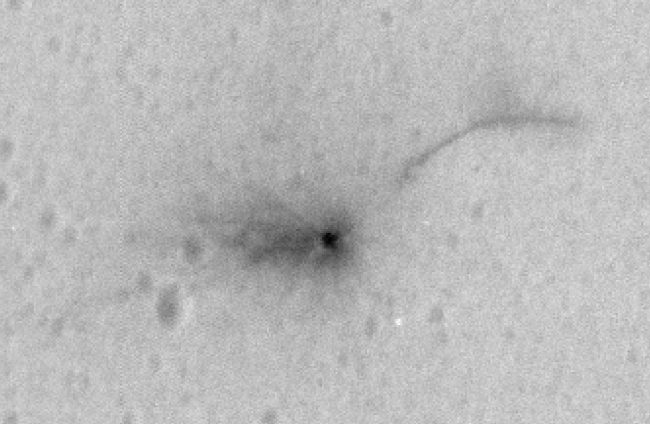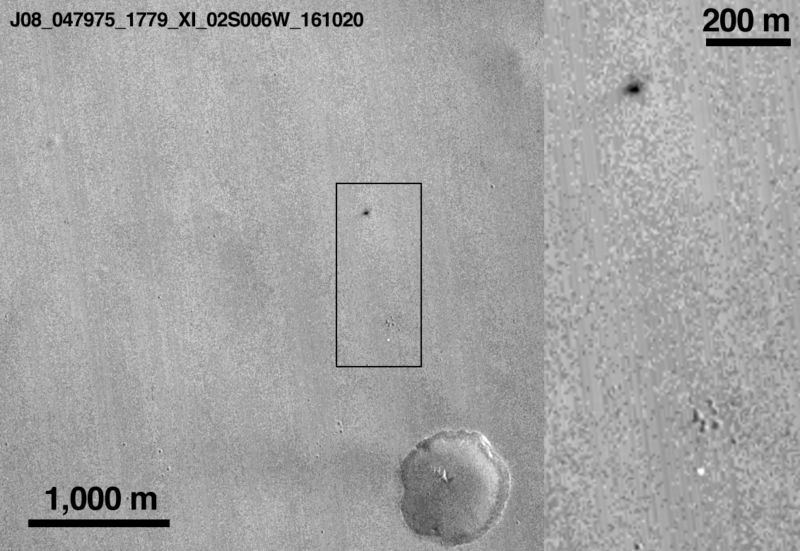
The spacecraft NASA’s Mars Reconaissance Orbiter (MRO) has provided new images of the crash site of the lander “Schiaparelli” in high resolution. The images confirm the assumption that the landing module was very heavy, but also raised questions about the nature of the accident.
The investigation of causes of accident of the module “Schiaparelli” the European space Agency began a week ago, right after the module has lost radio contact with the Ground. The module itself was a demonstration prototype, whose task was to test technologies that will be used during landing (I hope one) the new Rover to the Red planet in 2020.
Last week one of the cameras from the Orbiter, MRO taking a picture where ESA was going to land gently “Schiaparelli”. The image is clearly visible bright spot, which is actually the shot of the parachute module, a small area, it seems that a scorched surface is the fact that the remains of a crashed “Schiaparelli”.

The place of fall of “Schiaparelli”, photographed by camera Orbiter MRO 20 Oct
The probe MRO again flew over the crash site of the module and took a picture in high resolution the crash site, as well as a brilliant object in the 1.4 km to the South from the crashed module, which has proven itself to be a parachute and the rear heat shield. The third facility, located 1.4 kilometers from the crash site, most likely, is the front heat shield of the module.
View of the crash site is thought-provoking. Form of an impact crater from a falling module and the scattered wreckage of the “Schiaparelli” probably more like the fall of a meteorite at a low angle. The fact is that ESA announced earlier that the reduction of “Schiaparelli”, before landing system prematurely turned off the landing engines were almost vertically. Long dark curved stripe on the surface just northeast of the crash site, too, defies explanation. Perhaps these two are somehow associated with the explosion, which could occur in one of the fuel tanks of the module and are the result of remaining raw fuel. However, to confirm this hypothesis, it needs further analysis.

At the moment the command space mission “Eczemas” explores the telemetry data received from the mother ship “Schiaparelli” — reconnaissance Orbiter Trace Gas Orbiter — as well as information obtained from other orbiters and ground-based telescopes. Everything points to the fact that the landing started well, however, a series of events that happened in the last minute of landing, led to the accident. First before time was unbuckled parachute and rear heat shield. Then the landing engines first started, and then stopped their work prematurely, having worked instead of 30 seconds just 3.
In General, everything is indicating that the reason for the crashes are software bugs. Computer module for some reason misinformed landing system position and altitude of “Schiaparelli”, which led to a premature launch of the pre-programmed sequence of commands. If so, for ESA it will be a good news: a software error is much easier to solve than hardware.
The investigation of causes of accident “Schiaparelli” is still far from complete. In the coming weeks with the help of Orbiter MRO is scheduled to get a new image. You also need to understand the data obtained from the probe TGO. ESA promises to understand all the details by mid-November.
The place of fall of the module “Schiaparelli” in high resolution gave rise to new questions
Nikolai Khizhnyak
